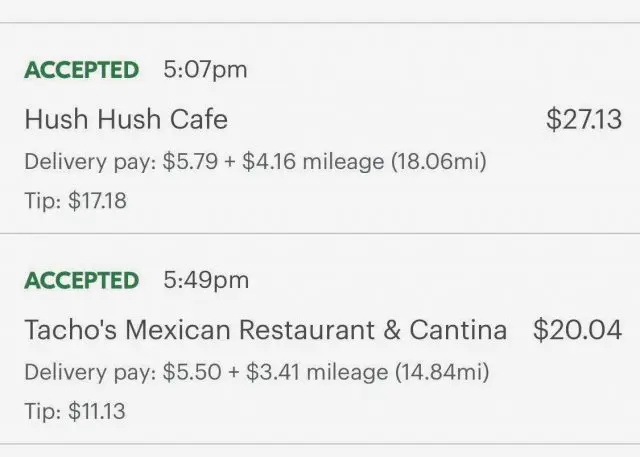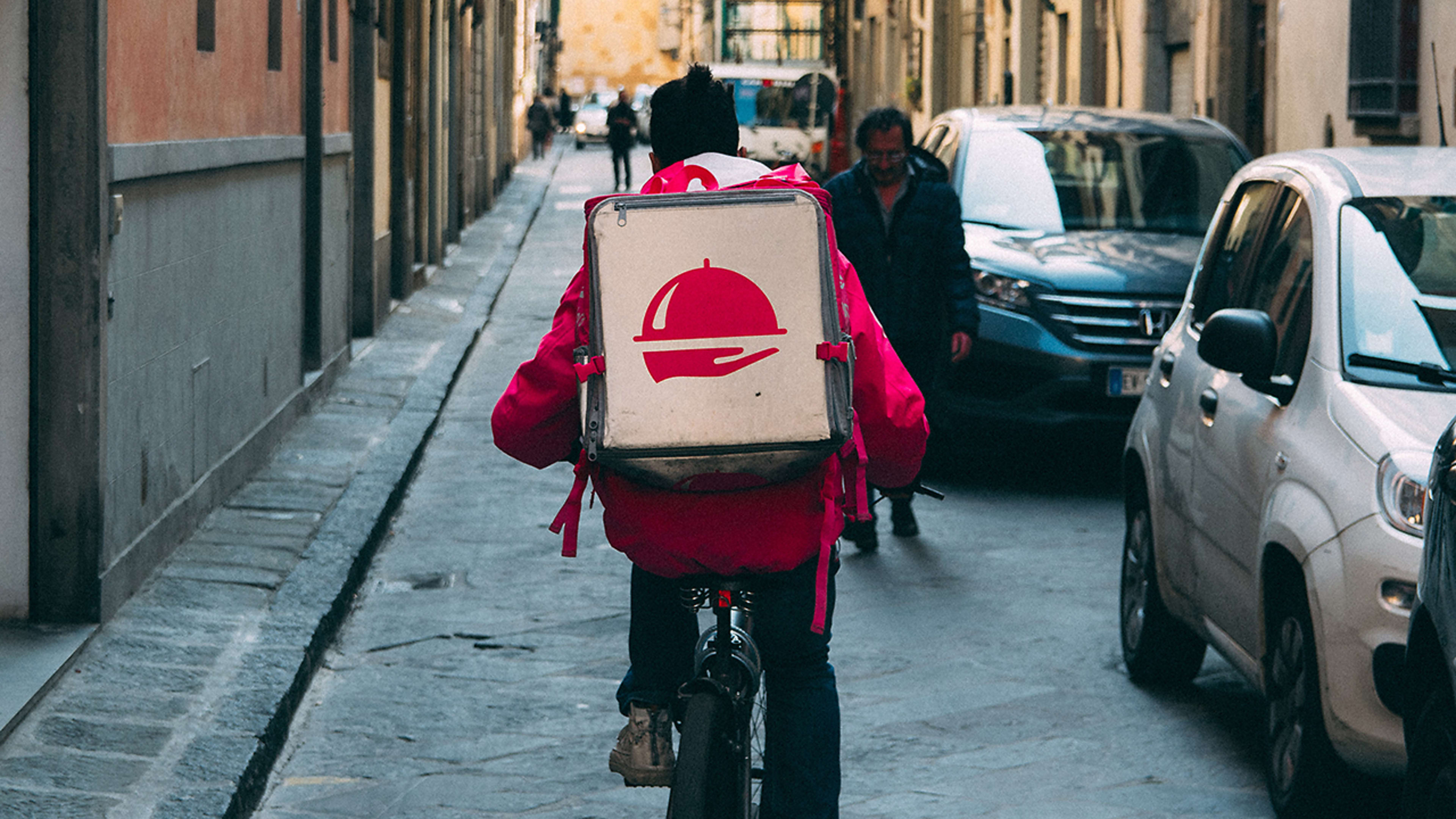Today’s technology is built on people. You may order a product online, but humans have to pack, ship, and deliver it to you. And while Uber and Lyft dream of autonomous cars, it seems that humans will be driving you for the foreseeable future. Aside from the techy interface, the gig economy differs little from the traditional service industries of cabbies, couriers, waitstaff, and store delivery folk.
So should the same tipping rules apply?
This week, drivers for grocery delivery service Instacart staged a strike to demand not better pay, but better tips. The app currently nudges customers with a default 5% tip (or $2, whichever is higher). Instacart’s freelance workers are demanding that it be upped to 10%.
They and workers for many other gig companies complain of ever-declining pay that makes tips more important to their bottom line. The hope is that a higher default amount could provide an important nudge to customers, who are navigating a relatively new industry without established norms. “There’s definitely no tipping etiquette [in the gig economy] like there is with restaurants or even coffee shops,” says gig worker Harry Campbell, who runs The Rideshare Guy blog.
Neither is there consistency among customers, says Jake Kronborg, a gig worker who covers the industry on his YouTube channel. “I’ve seen the customers that are used to tipping: They tip anywhere from 10% to 25% on average,” he says. That accounts for about half the customers he encounters driving for various services. “But there’s a lot of people that are not tipping.”
Related: Terrible tippers are making underpaid delivery jobs even worse
Tips may be affected not only by the lack of established guidelines but by customers reeling from sticker shock once they realize how expensive services can be. The fees on a burrito delivery, for instance, can cost more than the food itself.
Instacart drivers (known as “shoppers”) have listed delivery fees in their complaints in an open letter to the company’s CEO. The default tip had been 10% a few years ago, they say. Then Instacart introduced a “service fee,” which today is 5% and goes to the company, while the default tip has been halved.
That’s a lot to expect customers to understand and take into account when making tipping decisions. “I think it’s easy for customers to say, ‘I’m already paying a delivery fee. I assume the driver will get some of that and not tip,'” Campbell says. “I think a lot of them, they know that [they should tip] on the bottom of their heart, but they come up with an excuse not to do it.”
The tipping controversy has been starker at food-delivery service DoorDash (which recently purchased Caviar). Until September, the company used tips to heavily subsidize driver payments, sometimes kicking in as little as $1 if the tip was sufficiently high.
Bowing to months of pressure, the company introduced a range of minimum payments it would make regardless of tips. Those minimums now start at $2, instead of $1, and go up to $10. “Customers typically tip between $0 and $5,” says Alex, a DoorDash driver in Arizona, who asked that we not publish his last name for fear of retribution. Assignments paying at the lower end of the scale just don’t make sense to take without tips.
“So tips are a big percentage. I’d say two-thirds or more of our income,” Kronborg says. “We can do about three deliveries per hour. So at $2 base pay, we’re going to make $6 an hour, and we’re using our vehicles.”

GrubHub, which has been facing financial difficulties, updated its pay model this year to be based on time and mileage. Kronborg looked at the early implementation and found many payments from the company of $3 or less. (Another driver reports seeing many payments around $3, but others that are much higher.) GrubHub’s suggested tip to customers commonly ranges from 20% to 25%, the company says, based on the order total amount.
Instacart workers, meanwhile, often get offered $7 assignments that require shoppers to pick out and deliver dozens of products. “If you tip someone $5 to pick up and deliver a pizza,” says Instacart shopper Sandra Wiggins, “why would you suggest a $2 tip for someone to not only pick up and deliver your groceries, but also to spend the time to find the items and check out at the store?” (Wiggins recently started driving with GrubHub, which she says pays much better, overall, thanks to tips.)
And as independent contractors, gig workers also have to absorb expenses that employees wouldn’t, including gas, insurance, and higher payroll taxes.
The situation could change in California, which just passed a law that would force gig companies to make many contractors into employees, subject to minimum wage law and other protections. Companies are mobilizing their legal teams to justify why the law won’t apply to them. DoorDash, Instacart, Lyft, and Uber are also backing a ballot initiative to exempt them from the law in exchange for concessions including a guaranteed minimum hourly wage.
The best-case scenario for gig workers? Some get reliable pay and benefits in California, but not in most other places.
How much should you tip?
It’s understandable that customers are baffled by the need for big tips to supplement low pay in app-based services. But there is an entirely selfish reason to tip well—you’re more likely to get your order on time. “We do see the dollar amount on these orders,” says Kronborg. “So tipping does help ensure that their delivery is going to get picked up and delivered.”

Tip expectations differ depending on the kind of service, with ride sharing being the lowest, Campbell says. “Drivers love a tip, but the overwhelming majority don’t expect to get a tip,” he says. Ride-share drivers make their calculations based more on incentives from the companies, such as pay boosts for times of high demand, he says.
That’s a good thing, since tips are pretty rare, according to an analysis of 40 million Uber rides by the nonprofit National Bureau of Economic Research (NBER). A new working paper found that only about 16% of Uber rides were tipped. Furthermore, 60% of people never tipped, and only 1% always tipped, over the four weeks of data collection.
Still, drivers do rate their customers, so again there is a selfish reason to kick in a few bucks. Lyft’s app, for instance, allows users to set a default tip to be applied each time. It offers the choice of percentages: 0%, 10%, 15%, or 20%. Or users can set an amount in dollars: $0, $1, $2, or a custom tip.
Kronborg recommends tipping ride-share drivers based on the amount of time, rather than the mileage, since congestion or asking the driver to make a stop along the way will eat up their time.
But there are also a lot more factors to consider than for a delivery, like the car’s cleanliness (or lack thereof) and the quality of the driving.” “If it’s a 10-minute ride, [tip] two bucks. And again it depends on the experience of the person,” he says. “If it wasn’t very good, you might tip them zero or $1. If it was excellent, you might tip them $5.”
According to the NBER study, Uber drivers with a five-star rating are tipped almost 50% more often than those with a 4.75.
As mentioned, delivery drivers for services like GrubHub, Instacart, Postmates, or UberEats tend to rely more on tips. “It seems like customers tend to tip in the 10% to 15% range on delivery, which I think is reasonable,” Campbell says. “When you have exceptional service, up to 20%.”
A May survey by food service company U.S. Foods found that $4 seems to be the average amount customers tip for food delivery services.
What if the service is awful, such as squashed food or missing groceries? Most apps allow you to change a tip after the fact.
Kronborg recommends starting with a 10% tip for delivery people in the app. That’s enough to incentivize them to take the assignment. You can add more for an excellent job, which drivers appreciate getting in cash, Kronborg says. It makes a difference, especially for delivery companies that still use tips to subsidize pay—Amazon being the most prominent. They can’t see tips given in cash, instead of in the app, so they have to kick in more of their own money to make the minimum payments they guarantee workers.
Kronborg recommends the biggest tips for grocery delivery services like Instacart, DoorDash, and Target-owned Shipt, since each job typically involves a lot of extra hassle and stress. Shoppers have to navigate crowded stores, for instance, and communicate with customers about substitutions if the items they requested are out of stock. Then there’s the checkout lines. It’s too much for Kronborg, who prefers the quick-turnaround of meal deliveries like GrubHub.
“I’m just not a fan of grocery shopping,” Kronborg says. “It creates anxiety for me to go into grocery stores and do that.”
Given his aversion to grocery delivery, Kronborg says he’s happy to pay up to 25% in tip for excellent service. But as the recent Instacart strike shows, even 10% is well appreciated.
Recognize your brand’s excellence by applying to this year’s Brands That Matter Awards before the early-rate deadline, May 3.
